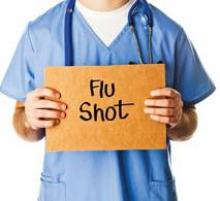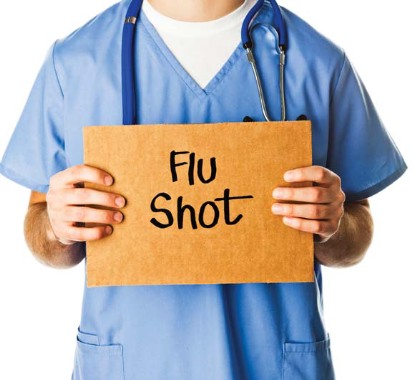User login
It’s late October, and a 70-year-old woman with a past medical history of type 2 diabetes and hypothyroidism, as well as a remote history of laryngeal cancer, presents with a COPD exacerbation. The records say she hasn’t had a flu shot. Would she get one at your center?
Experience says if there’s protocol in place designed for people like her, she’s in luck. But if there’s not ... her case points to room for quality improvement.
"The reason vaccinating patients has become a safety measure is that we have found that many patients will encounter health care by being seen in an emergency department, being admitted to a hospital, or being seen by their physician, and not receive the recommended vaccines, and later go on to develop illnesses that might be quite serious," said Dr. Thomas Talbot, author of the Society for Healthcare Epidemiology’s vaccination guidelines and chief hospital epidemiologist at Vanderbilt University Medical Center in Nashville, Tenn.
"These are missed opportunities when we have had patients in our health care system and haven’t taken advantage of the opportunity to vaccinate them," Dr. Talbot said.
"That has been the impetus for a lot of new quality measures for those patients who are admitted to the hospital. Once their acute issue has been cared for and they are getting ready to go home, get them their vaccines while you have them there," to protect them against influenza, and also pneumococcal disease, he said.
But it’s not always an easy thing to do, Dr. Talbot said.
"It is challenging to implement an inpatient vaccination program," he said. "During a hospitalization, you are trying to get the patient supported for the illness that brought them into the hospital. You don’t want to do anything that may interrupt that care plan," he said.
"I think the places that have seemed to hard-wire [a vaccination program] have locked it into a nurse-directed order set that may be implemented upon discharge, along with education. Or, [it] may be implemented a few days into the hospitalization so as to avoid that first 48 hours when a lot of activity is happening around the acute illness," Dr. Talbot said. This approach helps ensure that vaccination doesn’t fall off the radar, and allows time to get the vaccine as well as educate patients, he said.
"One of the challenges with this type of program is making sure that the patient’s outpatient provider is aware that they have received immunizations," Dr. Talbot added. "We don’t want individuals to get an unnecessary additional flu shot or pneumococcal vaccination," he said. Documentation and communication are key factors, as is having a mechanism in the hospital to track vaccinations so a returning patient does not receive a second vaccine unnecessarily, he said.
Another challenge to implementing inpatient immunization is the concern that some sick patients who receive a flu vaccine won’t mount the same immune response as they would while healthy, Dr. Talbot said.
"In particular populations, such as those immediately post transplant, where we know that the immune response would not be robust, immunization should be deferred," he emphasized.
"However, there is no evidence to suggest that giving a vaccine during a hospitalization will adversely impact the course of most illnesses for which people are admitted," he said.
Dr. Talbot also emphasized the importance of vaccination for health care workers.
In developing its Hospital Inpatient Quality measures, the Joint Commission looked to a 2006 National Quality Forum work group recommendation that "influenza and pneumococcal vaccination measures should apply to all patients regardless of diagnosis."
As of August 2012, a proposal from the Centers for Medicare and Medicaid Services requiring certain Medicare providers and suppliers to offer all eligible and consenting patients flu vaccination during flu season had not been approved, and flu vaccination policies and practices vary among hospitals.
But last January 1, inpatient immunization for pneumonia and influenza officially became a new Joint Commission core measure set for hospital accreditation programs. Because it is a such a new program, quarterly data have only recently begun to be categorized in this way, the commission said.
Polishing a Protocol
An inpatient immunization program is working in Boston at Beth Israel Deaconess Medical Center. BIDMC first initiated an inpatient flu immunization protocol in 2006, and it has been refined over time, said Dr. Alexander Carbo, a hospitalist in the division of general medicine and primary care at BIDMC, Jaime Levash, project administrator for QI and professional development, and Margie Serrano, RN, who work together as part of the medical center’s Influenza Inpatient Immunization Initiative. They described the BIDMC protocol as follows:
– When adult patients (aged 18 years and older) are admitted to BIDMC, the online medical record automatically checks to see when patients have been immunized (or have contraindications such as an allergy).
– If the patient’s vaccine status is unknown in our system, or if the patient previously refused vaccine, upon admission, the ordering providers are prompted to write for the influenza vaccine protocol, or to provide a reason for not initiating the protocol (such as a prior immunization, or allergy).
– If the protocol is initiated, the nursing staff screens the patient for appropriateness for vaccine and then either provides vaccine (with documentation) or documents the contraindication in the online medical record.
– During subsequent admissions, providers will be re-prompted to write for the vaccine protocol if the patient previously refused vaccine or if vaccine was not given (for a reason other than listed contraindications); otherwise, the prompt will not appear (the computer system tracks prior immunizations and contraindications, so as not to revaccinate patients or reprompt for patients with contraindications during the same influenza season).
The BIDMC team has tweaked the protocol over time to make it more effective at the 650-bed center, Dr. Carbo said. "We have added a hard stop at discharge to ensure that each patient’s immunization status is accounted for during their admission," he said.
Plans for the 2012-2013 flu season are similar to last year’s protocols, but will incorporate some of the newer CDC guidelines for immunizing patients with egg allergies, Dr. Carbo said.
In addition, "BIDMC mandates immunization for all employees in patient care areas (allowing exceptions for previously noted contraindications) and strongly encourages vaccination for all other staff," he noted.
Dr. Carbo’s advice to hospitalists about how to succeed in inpatient immunizations: "Work with a multidisciplinary team," he said. "When we started in 2006, I did this in collaboration with one of the nursing leaders. Now we have a multidisciplinary team that includes representatives from the nursing staff, the pharmacy staff, information systems, and communications," he said.
Read the Sign
The 566-bed University of Wisconsin Hospital Center (UWHC) in Madison is also harnessing the power of protocol.
"We realized that, as one of our quality control measures, we were monitoring what proportion of our patient population was being vaccinated against pneumonia and influenza and we weren’t doing as well as we would have liked," said Dr. Nasia Safdar, hospital epidemiologist for the UWHC.
Immunizing inpatients was a top choice among UWHC’s efforts to optimize vaccination, but, said Dr. Safdar: "It turned out quickly that it was easier said than done." But the Wisconsin hospital faced the challenge with a protocol similar to the one used at BIDMC. "It took a lot of the repeated questioning and thinking out of the equation because everyone is familiar with the protocol," Dr. Safdar said. "If a patient meets the criteria, they will be vaccinated."
Status is checked upon admission, and barring any specific objection or event, eligible patients get the vaccine at some point during their relationship with the Wisconsin hospital. For example, a transplant patient would not receive a vaccine at the time of the hospital stay for the transplant, but could be vaccinated at a follow-up visit 6 months later, she explained.
"Another thing we have done is to put notices on patients’ doors that say, ‘Eligible for Vaccination Before Discharge,’ and the pharmacist, who is typically involved in the discharge medication process, knows right away that this is a patient who needs to be vaccinated," she said. "It is a visible marker of something that needs to be done," Dr. Safdar said.
Dr. Talbot, Dr. Carbo, and Dr. Safdar reported having no financial conflicts to disclose.
**This story was updated Sept. 6, 2012.
It’s late October, and a 70-year-old woman with a past medical history of type 2 diabetes and hypothyroidism, as well as a remote history of laryngeal cancer, presents with a COPD exacerbation. The records say she hasn’t had a flu shot. Would she get one at your center?
Experience says if there’s protocol in place designed for people like her, she’s in luck. But if there’s not ... her case points to room for quality improvement.
"The reason vaccinating patients has become a safety measure is that we have found that many patients will encounter health care by being seen in an emergency department, being admitted to a hospital, or being seen by their physician, and not receive the recommended vaccines, and later go on to develop illnesses that might be quite serious," said Dr. Thomas Talbot, author of the Society for Healthcare Epidemiology’s vaccination guidelines and chief hospital epidemiologist at Vanderbilt University Medical Center in Nashville, Tenn.
"These are missed opportunities when we have had patients in our health care system and haven’t taken advantage of the opportunity to vaccinate them," Dr. Talbot said.
"That has been the impetus for a lot of new quality measures for those patients who are admitted to the hospital. Once their acute issue has been cared for and they are getting ready to go home, get them their vaccines while you have them there," to protect them against influenza, and also pneumococcal disease, he said.
But it’s not always an easy thing to do, Dr. Talbot said.
"It is challenging to implement an inpatient vaccination program," he said. "During a hospitalization, you are trying to get the patient supported for the illness that brought them into the hospital. You don’t want to do anything that may interrupt that care plan," he said.
"I think the places that have seemed to hard-wire [a vaccination program] have locked it into a nurse-directed order set that may be implemented upon discharge, along with education. Or, [it] may be implemented a few days into the hospitalization so as to avoid that first 48 hours when a lot of activity is happening around the acute illness," Dr. Talbot said. This approach helps ensure that vaccination doesn’t fall off the radar, and allows time to get the vaccine as well as educate patients, he said.
"One of the challenges with this type of program is making sure that the patient’s outpatient provider is aware that they have received immunizations," Dr. Talbot added. "We don’t want individuals to get an unnecessary additional flu shot or pneumococcal vaccination," he said. Documentation and communication are key factors, as is having a mechanism in the hospital to track vaccinations so a returning patient does not receive a second vaccine unnecessarily, he said.
Another challenge to implementing inpatient immunization is the concern that some sick patients who receive a flu vaccine won’t mount the same immune response as they would while healthy, Dr. Talbot said.
"In particular populations, such as those immediately post transplant, where we know that the immune response would not be robust, immunization should be deferred," he emphasized.
"However, there is no evidence to suggest that giving a vaccine during a hospitalization will adversely impact the course of most illnesses for which people are admitted," he said.
Dr. Talbot also emphasized the importance of vaccination for health care workers.
In developing its Hospital Inpatient Quality measures, the Joint Commission looked to a 2006 National Quality Forum work group recommendation that "influenza and pneumococcal vaccination measures should apply to all patients regardless of diagnosis."
As of August 2012, a proposal from the Centers for Medicare and Medicaid Services requiring certain Medicare providers and suppliers to offer all eligible and consenting patients flu vaccination during flu season had not been approved, and flu vaccination policies and practices vary among hospitals.
But last January 1, inpatient immunization for pneumonia and influenza officially became a new Joint Commission core measure set for hospital accreditation programs. Because it is a such a new program, quarterly data have only recently begun to be categorized in this way, the commission said.
Polishing a Protocol
An inpatient immunization program is working in Boston at Beth Israel Deaconess Medical Center. BIDMC first initiated an inpatient flu immunization protocol in 2006, and it has been refined over time, said Dr. Alexander Carbo, a hospitalist in the division of general medicine and primary care at BIDMC, Jaime Levash, project administrator for QI and professional development, and Margie Serrano, RN, who work together as part of the medical center’s Influenza Inpatient Immunization Initiative. They described the BIDMC protocol as follows:
– When adult patients (aged 18 years and older) are admitted to BIDMC, the online medical record automatically checks to see when patients have been immunized (or have contraindications such as an allergy).
– If the patient’s vaccine status is unknown in our system, or if the patient previously refused vaccine, upon admission, the ordering providers are prompted to write for the influenza vaccine protocol, or to provide a reason for not initiating the protocol (such as a prior immunization, or allergy).
– If the protocol is initiated, the nursing staff screens the patient for appropriateness for vaccine and then either provides vaccine (with documentation) or documents the contraindication in the online medical record.
– During subsequent admissions, providers will be re-prompted to write for the vaccine protocol if the patient previously refused vaccine or if vaccine was not given (for a reason other than listed contraindications); otherwise, the prompt will not appear (the computer system tracks prior immunizations and contraindications, so as not to revaccinate patients or reprompt for patients with contraindications during the same influenza season).
The BIDMC team has tweaked the protocol over time to make it more effective at the 650-bed center, Dr. Carbo said. "We have added a hard stop at discharge to ensure that each patient’s immunization status is accounted for during their admission," he said.
Plans for the 2012-2013 flu season are similar to last year’s protocols, but will incorporate some of the newer CDC guidelines for immunizing patients with egg allergies, Dr. Carbo said.
In addition, "BIDMC mandates immunization for all employees in patient care areas (allowing exceptions for previously noted contraindications) and strongly encourages vaccination for all other staff," he noted.
Dr. Carbo’s advice to hospitalists about how to succeed in inpatient immunizations: "Work with a multidisciplinary team," he said. "When we started in 2006, I did this in collaboration with one of the nursing leaders. Now we have a multidisciplinary team that includes representatives from the nursing staff, the pharmacy staff, information systems, and communications," he said.
Read the Sign
The 566-bed University of Wisconsin Hospital Center (UWHC) in Madison is also harnessing the power of protocol.
"We realized that, as one of our quality control measures, we were monitoring what proportion of our patient population was being vaccinated against pneumonia and influenza and we weren’t doing as well as we would have liked," said Dr. Nasia Safdar, hospital epidemiologist for the UWHC.
Immunizing inpatients was a top choice among UWHC’s efforts to optimize vaccination, but, said Dr. Safdar: "It turned out quickly that it was easier said than done." But the Wisconsin hospital faced the challenge with a protocol similar to the one used at BIDMC. "It took a lot of the repeated questioning and thinking out of the equation because everyone is familiar with the protocol," Dr. Safdar said. "If a patient meets the criteria, they will be vaccinated."
Status is checked upon admission, and barring any specific objection or event, eligible patients get the vaccine at some point during their relationship with the Wisconsin hospital. For example, a transplant patient would not receive a vaccine at the time of the hospital stay for the transplant, but could be vaccinated at a follow-up visit 6 months later, she explained.
"Another thing we have done is to put notices on patients’ doors that say, ‘Eligible for Vaccination Before Discharge,’ and the pharmacist, who is typically involved in the discharge medication process, knows right away that this is a patient who needs to be vaccinated," she said. "It is a visible marker of something that needs to be done," Dr. Safdar said.
Dr. Talbot, Dr. Carbo, and Dr. Safdar reported having no financial conflicts to disclose.
**This story was updated Sept. 6, 2012.
It’s late October, and a 70-year-old woman with a past medical history of type 2 diabetes and hypothyroidism, as well as a remote history of laryngeal cancer, presents with a COPD exacerbation. The records say she hasn’t had a flu shot. Would she get one at your center?
Experience says if there’s protocol in place designed for people like her, she’s in luck. But if there’s not ... her case points to room for quality improvement.
"The reason vaccinating patients has become a safety measure is that we have found that many patients will encounter health care by being seen in an emergency department, being admitted to a hospital, or being seen by their physician, and not receive the recommended vaccines, and later go on to develop illnesses that might be quite serious," said Dr. Thomas Talbot, author of the Society for Healthcare Epidemiology’s vaccination guidelines and chief hospital epidemiologist at Vanderbilt University Medical Center in Nashville, Tenn.
"These are missed opportunities when we have had patients in our health care system and haven’t taken advantage of the opportunity to vaccinate them," Dr. Talbot said.
"That has been the impetus for a lot of new quality measures for those patients who are admitted to the hospital. Once their acute issue has been cared for and they are getting ready to go home, get them their vaccines while you have them there," to protect them against influenza, and also pneumococcal disease, he said.
But it’s not always an easy thing to do, Dr. Talbot said.
"It is challenging to implement an inpatient vaccination program," he said. "During a hospitalization, you are trying to get the patient supported for the illness that brought them into the hospital. You don’t want to do anything that may interrupt that care plan," he said.
"I think the places that have seemed to hard-wire [a vaccination program] have locked it into a nurse-directed order set that may be implemented upon discharge, along with education. Or, [it] may be implemented a few days into the hospitalization so as to avoid that first 48 hours when a lot of activity is happening around the acute illness," Dr. Talbot said. This approach helps ensure that vaccination doesn’t fall off the radar, and allows time to get the vaccine as well as educate patients, he said.
"One of the challenges with this type of program is making sure that the patient’s outpatient provider is aware that they have received immunizations," Dr. Talbot added. "We don’t want individuals to get an unnecessary additional flu shot or pneumococcal vaccination," he said. Documentation and communication are key factors, as is having a mechanism in the hospital to track vaccinations so a returning patient does not receive a second vaccine unnecessarily, he said.
Another challenge to implementing inpatient immunization is the concern that some sick patients who receive a flu vaccine won’t mount the same immune response as they would while healthy, Dr. Talbot said.
"In particular populations, such as those immediately post transplant, where we know that the immune response would not be robust, immunization should be deferred," he emphasized.
"However, there is no evidence to suggest that giving a vaccine during a hospitalization will adversely impact the course of most illnesses for which people are admitted," he said.
Dr. Talbot also emphasized the importance of vaccination for health care workers.
In developing its Hospital Inpatient Quality measures, the Joint Commission looked to a 2006 National Quality Forum work group recommendation that "influenza and pneumococcal vaccination measures should apply to all patients regardless of diagnosis."
As of August 2012, a proposal from the Centers for Medicare and Medicaid Services requiring certain Medicare providers and suppliers to offer all eligible and consenting patients flu vaccination during flu season had not been approved, and flu vaccination policies and practices vary among hospitals.
But last January 1, inpatient immunization for pneumonia and influenza officially became a new Joint Commission core measure set for hospital accreditation programs. Because it is a such a new program, quarterly data have only recently begun to be categorized in this way, the commission said.
Polishing a Protocol
An inpatient immunization program is working in Boston at Beth Israel Deaconess Medical Center. BIDMC first initiated an inpatient flu immunization protocol in 2006, and it has been refined over time, said Dr. Alexander Carbo, a hospitalist in the division of general medicine and primary care at BIDMC, Jaime Levash, project administrator for QI and professional development, and Margie Serrano, RN, who work together as part of the medical center’s Influenza Inpatient Immunization Initiative. They described the BIDMC protocol as follows:
– When adult patients (aged 18 years and older) are admitted to BIDMC, the online medical record automatically checks to see when patients have been immunized (or have contraindications such as an allergy).
– If the patient’s vaccine status is unknown in our system, or if the patient previously refused vaccine, upon admission, the ordering providers are prompted to write for the influenza vaccine protocol, or to provide a reason for not initiating the protocol (such as a prior immunization, or allergy).
– If the protocol is initiated, the nursing staff screens the patient for appropriateness for vaccine and then either provides vaccine (with documentation) or documents the contraindication in the online medical record.
– During subsequent admissions, providers will be re-prompted to write for the vaccine protocol if the patient previously refused vaccine or if vaccine was not given (for a reason other than listed contraindications); otherwise, the prompt will not appear (the computer system tracks prior immunizations and contraindications, so as not to revaccinate patients or reprompt for patients with contraindications during the same influenza season).
The BIDMC team has tweaked the protocol over time to make it more effective at the 650-bed center, Dr. Carbo said. "We have added a hard stop at discharge to ensure that each patient’s immunization status is accounted for during their admission," he said.
Plans for the 2012-2013 flu season are similar to last year’s protocols, but will incorporate some of the newer CDC guidelines for immunizing patients with egg allergies, Dr. Carbo said.
In addition, "BIDMC mandates immunization for all employees in patient care areas (allowing exceptions for previously noted contraindications) and strongly encourages vaccination for all other staff," he noted.
Dr. Carbo’s advice to hospitalists about how to succeed in inpatient immunizations: "Work with a multidisciplinary team," he said. "When we started in 2006, I did this in collaboration with one of the nursing leaders. Now we have a multidisciplinary team that includes representatives from the nursing staff, the pharmacy staff, information systems, and communications," he said.
Read the Sign
The 566-bed University of Wisconsin Hospital Center (UWHC) in Madison is also harnessing the power of protocol.
"We realized that, as one of our quality control measures, we were monitoring what proportion of our patient population was being vaccinated against pneumonia and influenza and we weren’t doing as well as we would have liked," said Dr. Nasia Safdar, hospital epidemiologist for the UWHC.
Immunizing inpatients was a top choice among UWHC’s efforts to optimize vaccination, but, said Dr. Safdar: "It turned out quickly that it was easier said than done." But the Wisconsin hospital faced the challenge with a protocol similar to the one used at BIDMC. "It took a lot of the repeated questioning and thinking out of the equation because everyone is familiar with the protocol," Dr. Safdar said. "If a patient meets the criteria, they will be vaccinated."
Status is checked upon admission, and barring any specific objection or event, eligible patients get the vaccine at some point during their relationship with the Wisconsin hospital. For example, a transplant patient would not receive a vaccine at the time of the hospital stay for the transplant, but could be vaccinated at a follow-up visit 6 months later, she explained.
"Another thing we have done is to put notices on patients’ doors that say, ‘Eligible for Vaccination Before Discharge,’ and the pharmacist, who is typically involved in the discharge medication process, knows right away that this is a patient who needs to be vaccinated," she said. "It is a visible marker of something that needs to be done," Dr. Safdar said.
Dr. Talbot, Dr. Carbo, and Dr. Safdar reported having no financial conflicts to disclose.
**This story was updated Sept. 6, 2012.




